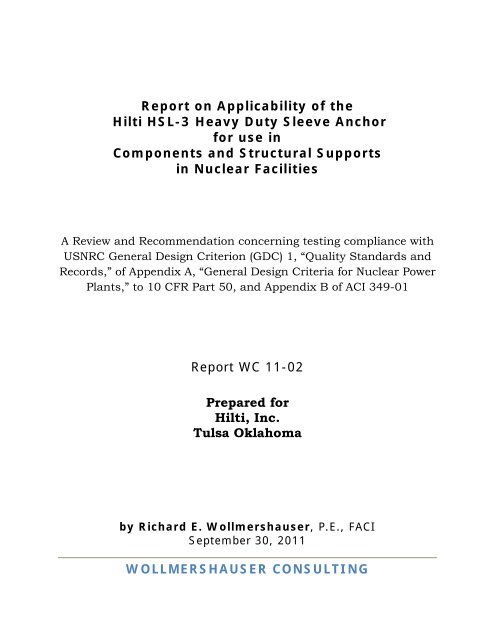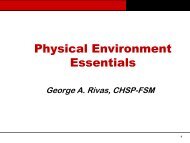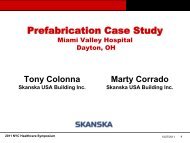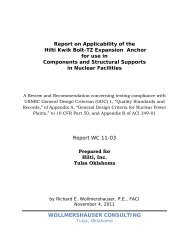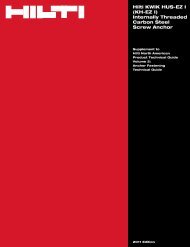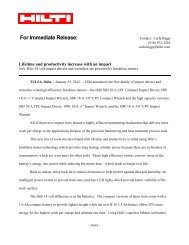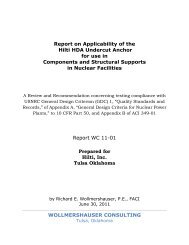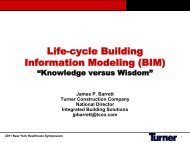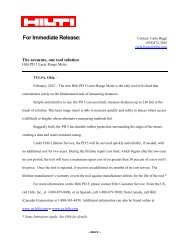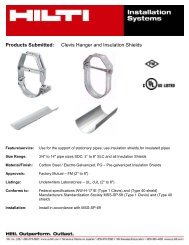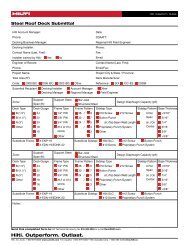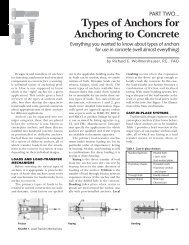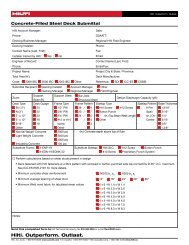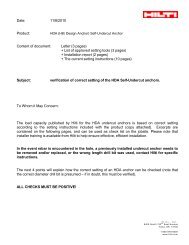HSL-3 Nuclear Report on Testing and Evaluation - Hilti Egypt
HSL-3 Nuclear Report on Testing and Evaluation - Hilti Egypt
HSL-3 Nuclear Report on Testing and Evaluation - Hilti Egypt
You also want an ePaper? Increase the reach of your titles
YUMPU automatically turns print PDFs into web optimized ePapers that Google loves.
<str<strong>on</strong>g>Report</str<strong>on</strong>g> <strong>on</strong> Applicability of the<br />
<strong>Hilti</strong> <str<strong>on</strong>g>HSL</str<strong>on</strong>g>-3 Heavy Duty Sleeve Anchor<br />
for use in<br />
Comp<strong>on</strong>ents <strong>and</strong> Structural Supports<br />
in <str<strong>on</strong>g>Nuclear</str<strong>on</strong>g> Facilities<br />
A Review <strong>and</strong> Recommendati<strong>on</strong> c<strong>on</strong>cerning testing compliance with<br />
USNRC General Design Criteri<strong>on</strong> (GDC) 1, “Quality St<strong>and</strong>ards <strong>and</strong><br />
Records,” of Appendix A, “General Design Criteria for <str<strong>on</strong>g>Nuclear</str<strong>on</strong>g> Power<br />
Plants,” to 10 CFR Part 50, <strong>and</strong> Appendix B of ACI 349-01<br />
<str<strong>on</strong>g>Report</str<strong>on</strong>g> WC 11-02<br />
Prepared for<br />
<strong>Hilti</strong>, Inc.<br />
Tulsa Oklahoma<br />
by Richard E. Wollmershauser, P.E., FACI<br />
September 30, 2011<br />
WOLLMERSHAUSER CONSULTING
<str<strong>on</strong>g>Report</str<strong>on</strong>g> WC 11-02 <strong>Hilti</strong> <str<strong>on</strong>g>HSL</str<strong>on</strong>g>-3 Compliance September 30, 2011<br />
Tulsa, Oklahoma<br />
Table of C<strong>on</strong>tents<br />
1. Purpose <strong>and</strong> Scope.……………………………………………………………1<br />
2. Qualificati<strong>on</strong> <strong>Testing</strong> Program..……………………………………………2<br />
3. <strong>Testing</strong> Differences am<strong>on</strong>g ICC-ES AC193, ACI 355.2-01, <strong>and</strong><br />
ACI 349-01 Requirements <strong>and</strong> Resoluti<strong>on</strong> of those Differences…3<br />
4. C<strong>on</strong>clusi<strong>on</strong>s <strong>and</strong> Recommendati<strong>on</strong>s………………………………………8<br />
5. References…………………………………………………………………………9<br />
6. Appendix A………………………………………………………………………10<br />
ii
<str<strong>on</strong>g>Report</str<strong>on</strong>g> WC 11-02 <strong>Hilti</strong> <str<strong>on</strong>g>HSL</str<strong>on</strong>g>-3 Compliance September 30, 2011<br />
1. Purpose <strong>and</strong> Scope<br />
<strong>Hilti</strong> has developed an expansi<strong>on</strong> anchor known as the <str<strong>on</strong>g>HSL</str<strong>on</strong>g>-3 Heavy Duty<br />
Sleeve Anchor System. The purpose of this document is to evaluate the<br />
qualificati<strong>on</strong> testing performed <strong>on</strong> the <strong>Hilti</strong> <str<strong>on</strong>g>HSL</str<strong>on</strong>g>-3 Heavy Duty Sleeve Anchor<br />
System <strong>and</strong> determine whether it is in compliance with the requirements of ACI<br />
355.2-01 <strong>and</strong> ACI 349-01 as recognized by the United States <str<strong>on</strong>g>Nuclear</str<strong>on</strong>g><br />
Regulatory Commissi<strong>on</strong> in USNRC Regulatory Guide 1.199.<br />
A design guide for use of the <str<strong>on</strong>g>HSL</str<strong>on</strong>g>-3 anchor system under ACI 349-01 <strong>and</strong><br />
USNRC Directive 1.199 is given in Appendix A (supplied by <strong>Hilti</strong>, Inc.). All data<br />
in Appendix A meets the requirements of these two documents.<br />
1
<str<strong>on</strong>g>Report</str<strong>on</strong>g> WC 11-02 <strong>Hilti</strong> <str<strong>on</strong>g>HSL</str<strong>on</strong>g>-3 Compliance September 30, 2011<br />
2. Qualificati<strong>on</strong> <strong>Testing</strong> Program<br />
2.1 <strong>Testing</strong> was ordered by <strong>Hilti</strong> in 2003 <strong>and</strong> c<strong>on</strong>ducted under the guidance of<br />
Prof. Dr.-ing Rolf Eligehausen of the University of Stuttgart, Germany in 2003<br />
at the Institut Für Werkstoffe Im Bauwesen <strong>and</strong> other testing laboratories.<br />
<strong>Testing</strong> was performed according to AC193.<br />
2.2 AC193 issued by the ICC Evaluati<strong>on</strong> Service references ACI 355.2 as the<br />
base document for the testing <strong>and</strong> evaluati<strong>on</strong> protocol, adding additi<strong>on</strong>al ICC-<br />
ES specific requirements as well as modificati<strong>on</strong>s to specific testing <strong>and</strong><br />
evaluati<strong>on</strong> requirements. Those differences <strong>and</strong> the resulting anchor<br />
qualificati<strong>on</strong> <strong>and</strong> <str<strong>on</strong>g>HSL</str<strong>on</strong>g>-3 design data will be the focus of this document.<br />
2.3 For anchors to be used in facilities under the purview of the USNRC,<br />
USNRC requirements must be met. Those requirements are summarized in<br />
Regulatory Guide 1.199. In that guide, ACI 349-01 Appendix B Anchoring to<br />
C<strong>on</strong>crete c<strong>on</strong>tains the basic design requirements for anchoring, <strong>and</strong> ACI 355.2<br />
is an acceptable testing guide for mechanical anchors.<br />
2.4 All submitted testing of the <str<strong>on</strong>g>HSL</str<strong>on</strong>g>-3 Heavy Duty Sleeve Anchor System was<br />
performed in a satisfactory manner <strong>and</strong> submitted to ICC-ES for their review.<br />
After c<strong>on</strong>siderable review, an evaluati<strong>on</strong> service report (ESR) was issued, ESR<br />
1545, which recognized compliance with AC193. The ESR specified the<br />
appropriate design data <strong>and</strong> parameters for use with ACI 318-02, Appendix D.<br />
2.5 Because of differences in evaluati<strong>on</strong> requirements between ACI 355.2-01<br />
<strong>and</strong> actual testing performed under AC193, this report has been prepared to<br />
explain <strong>and</strong> comment <strong>on</strong> those differences.<br />
2
<str<strong>on</strong>g>Report</str<strong>on</strong>g> WC 11-02 <strong>Hilti</strong> <str<strong>on</strong>g>HSL</str<strong>on</strong>g>-3 Compliance September 30, 2011<br />
3. <strong>Testing</strong> Differences am<strong>on</strong>g ICC-ES AC193, ACI 355.2-01,<br />
<strong>and</strong> ACI 349-01 Requirements <strong>and</strong> Resoluti<strong>on</strong> of those<br />
Differences<br />
3.1 <strong>Testing</strong> to be performed or witnessed by an accredited<br />
laboratory.<br />
ACI 355.2-01 in Secti<strong>on</strong> 12.1states that,<br />
“The testing <strong>and</strong> evaluati<strong>on</strong> of anchors under ACI 355.2-01 shall be<br />
performed or witnessed by an independent testing <strong>and</strong> evaluati<strong>on</strong><br />
agency listed by a recognized accreditati<strong>on</strong> service c<strong>on</strong>forming to the<br />
requirements of ISO Guides 25 <strong>and</strong> 58. In additi<strong>on</strong> to these<br />
st<strong>and</strong>ards, listing of the <strong>Testing</strong> <strong>and</strong> Evaluati<strong>on</strong> Agency shall be<br />
predicated <strong>on</strong> the documented experience in the testing <strong>and</strong> evaluati<strong>on</strong><br />
of anchors according to ASTM E 488 including dem<strong>on</strong>strated<br />
competence to perform the tests described in ACI 355.2-01.”<br />
ACI 349-01 states in Secti<strong>on</strong> B3.3 that,<br />
“Post-installed structural anchors shall be tested before use to verify<br />
that they are capable of sustaining their design strength in cracked<br />
c<strong>on</strong>crete under seismic loads. These verificati<strong>on</strong> tests shall be<br />
c<strong>on</strong>ducted by an independent testing agency <strong>and</strong> shall be certified<br />
by a professi<strong>on</strong>al engineer with full descripti<strong>on</strong> <strong>and</strong> details of the<br />
testing programs, procedures, results, <strong>and</strong> c<strong>on</strong>clusi<strong>on</strong>s.”<br />
Test data obtained for the <str<strong>on</strong>g>HSL</str<strong>on</strong>g>-3 evaluati<strong>on</strong> according to Annex 1, Secti<strong>on</strong> 5.3,<br />
of AC193, was required to be performed in a laboratory accredited under the<br />
requirements of ISO/IEC 17025. Further, a listing, by an accredited listing<br />
agency, of the testing <strong>and</strong> evaluati<strong>on</strong> laboratory was required to be based <strong>on</strong><br />
the documented experience in the testing <strong>and</strong> evaluati<strong>on</strong> of anchors according<br />
to ASTM E 488.<br />
Resoluti<strong>on</strong>: <strong>Testing</strong> was performed primarily by the Institut Für Werkstoffe Im<br />
Bauwesen. Other laboratories were also used as given in the following list,<br />
taken from the evaluati<strong>on</strong> report prepared by Prof. Eligehausen. All of the listed<br />
laboratories were accredited by the Internati<strong>on</strong>al Laboratory Accreditati<strong>on</strong><br />
Cooperati<strong>on</strong> (ILAC) under ISO/IEC 17025. IAS, the laboratory <strong>and</strong> testing<br />
accrediting body of the ICC, is also a member of ILAC. The European<br />
accreditati<strong>on</strong> of these testing laboratories was accepted as being competent in<br />
the testing of anchor systems. CSTB was accredited in direct audits by IAS.<br />
3
<str<strong>on</strong>g>Report</str<strong>on</strong>g> WC 11-02 <strong>Hilti</strong> <str<strong>on</strong>g>HSL</str<strong>on</strong>g>-3 Compliance September 30, 2011<br />
Table 1—<strong>Testing</strong> laboratories used for <str<strong>on</strong>g>HSL</str<strong>on</strong>g>-3 testing<br />
1. CSTB: Centre Scientific et Technique du Batiment, Marne-la-<br />
Vallee, France (accredited by COFRAC (full ILAC-member)<br />
2. IWB: Institut für Werkstoffe im Bauwesen der Universität<br />
Stuttgart, Germany (accredited by ICC ES, IAS, <strong>and</strong> DAR (full ILACmember))<br />
3. Bautest: Gesellschaft für Forschung und Materialprüfung im<br />
Bauwesen GmbH, Augsburg (accredited by DAP (full ILAC-member))<br />
4. IFBT: Institut für Fassaden- und Befestigungstechnik GmbH<br />
Liepzig, Germany (DIBt-accredited)<br />
Limited testing was performed by the manufacturer<br />
5. H: <strong>Hilti</strong> Entwicklung Befestigungstechnik, Kaufering, Germany or<br />
<strong>Hilti</strong> K<strong>on</strong>zern-Forschung<br />
3.2 <strong>Testing</strong> under the directi<strong>on</strong> of a licensed professi<strong>on</strong>al engineer.<br />
ACI 355.2-01 states in Secti<strong>on</strong> 12.2 that, ”The testing shall be witnessed <strong>and</strong><br />
evaluated by a registered engineer employed or retained by the independent<br />
testing <strong>and</strong> evaluati<strong>on</strong> agency.”<br />
Resoluti<strong>on</strong>: <strong>Testing</strong> was overseen by <strong>and</strong> the Evaluati<strong>on</strong> report submittal<br />
prepared by Prof. Dr.-Ing. Rolf Eligehausen of the University of Stuttgart<br />
Institute for Building Materials. (He is now retired.) Prof. Eligehausen is not a<br />
registered engineer because there is no formal engineering registrati<strong>on</strong> system<br />
in Europe. Note that in Europe, licensing of structural engineers is<br />
accomplished through accredited educati<strong>on</strong>al instituti<strong>on</strong>s. Prof. Eligehausen is<br />
accredited for performing structural engineering. His experience in the<br />
technology of fastening to c<strong>on</strong>crete is significant.<br />
Prof. Eligehausen has been c<strong>on</strong>ducting evaluati<strong>on</strong> <strong>and</strong> approval of anchors in<br />
Europe for more than 25 years, initially under DIBt (German) rules, <strong>and</strong> later<br />
under the EOTA (European Organisati<strong>on</strong> for Technical Approvals<br />
(http://www.eota.be) guidelines. He participated in the development of the<br />
criteria for qualificati<strong>on</strong> of anchor systems both in Europe <strong>and</strong> the United<br />
States. As the author or co-author of over 230 papers <strong>and</strong> publicati<strong>on</strong>s in<br />
Europe <strong>and</strong> the U.S. <strong>on</strong> the subject of b<strong>on</strong>d <strong>and</strong> anchorage <strong>and</strong> as a Fellow of<br />
the American C<strong>on</strong>crete Institute, Prof. Eligehausen has established a<br />
reputati<strong>on</strong> <strong>on</strong> both sides of the Atlantic as the pre-eminent expert in the world<br />
4
<str<strong>on</strong>g>Report</str<strong>on</strong>g> WC 11-02 <strong>Hilti</strong> <str<strong>on</strong>g>HSL</str<strong>on</strong>g>-3 Compliance September 30, 2011<br />
<strong>on</strong> anchorage to c<strong>on</strong>crete. In additi<strong>on</strong>, Prof. Eligehausen c<strong>on</strong>ducts his own<br />
structural engineering practice as founder <strong>and</strong> principal of IEA (Ingenieurbüro<br />
Eligehausen und Asmus http://www.i-ea.de).<br />
3.3 Method used to calculate the effectiveness factor, k.<br />
Both ACI 355.2-01 <strong>and</strong> ACI 349-01 require that the k-factor (effectiveness<br />
factor, whose value depends <strong>on</strong> the type of anchor) reported for the anchors be<br />
calculated from the 5% fractile of the test data. ICC-ES AC193 allows the mean<br />
values to be used as an alternative to the 5% fractile, <strong>and</strong> ICC-ES ESR 1545<br />
reports the k-factor calculated from the mean test data.<br />
Resoluti<strong>on</strong>: The original test data used in developing ESR 1545 was evaluated<br />
using both the 5% fractile <strong>and</strong> mean values. There is no difference between the<br />
k-factors using the 5% fractile of the test data <strong>and</strong> the mean test data. The<br />
published values in ESR 1545 were based <strong>on</strong> the mean values. The values used<br />
in Appendix A—Design informati<strong>on</strong> for the <strong>Hilti</strong> Heavy Duty Sleeve Anchor<br />
<str<strong>on</strong>g>HSL</str<strong>on</strong>g>-3 in Accordance with ACI 349-01 Appendix B were based <strong>on</strong> 5% fractile<br />
calculati<strong>on</strong>s. They are the same.<br />
Table 2—Comparis<strong>on</strong> of effectiveness factors, k (in.-lb units)<br />
Uncracked c<strong>on</strong>crete Cracked c<strong>on</strong>crete<br />
Based <strong>on</strong> both mean <strong>and</strong> 5% fractile calculati<strong>on</strong><br />
M8 24 17<br />
M10 24 21<br />
M12 24 21<br />
M16 24 21<br />
M20 24 21<br />
M24 24 21<br />
3.4 Calculati<strong>on</strong> of c<strong>on</strong>crete compressive strengths.<br />
Since the testing was performed in a German test laboratory, the c<strong>on</strong>crete<br />
compressive strengths were determined according to European st<strong>and</strong>ards<br />
using the 150 mm cube strength rather than the 150 mm x 300 mm cylinder<br />
strengths used typically in the United States.<br />
Resoluti<strong>on</strong>: In the evaluati<strong>on</strong> performed for ESR 1545, these cube strengths<br />
were c<strong>on</strong>verted from SI units to in.-lb units using st<strong>and</strong>ard c<strong>on</strong>versi<strong>on</strong><br />
equati<strong>on</strong>s that have been universally accepted in both the European <strong>and</strong><br />
United States c<strong>on</strong>crete industry. They are as follows.<br />
f c,cyl = f c,cube 150 /1.25 for low strength c<strong>on</strong>crete f c,cyl < 50 N/mm 2<br />
f c,cyl = f c,cube 150 /1.05 for low strength c<strong>on</strong>crete f c,cyl ≥ 50 N/mm 2<br />
5
<str<strong>on</strong>g>Report</str<strong>on</strong>g> WC 11-02 <strong>Hilti</strong> <str<strong>on</strong>g>HSL</str<strong>on</strong>g>-3 Compliance September 30, 2011<br />
3.5 Questi<strong>on</strong> <strong>on</strong> measurement of ductility of the <str<strong>on</strong>g>HSL</str<strong>on</strong>g>-3 anchor steel.<br />
ACI 355.2-01 does not c<strong>on</strong>tain criteria for establishing the ductility of<br />
mechanical anchor steel. ACI 318-02 (Secti<strong>on</strong> D.1 Definiti<strong>on</strong>s) define it as,<br />
“ductile steel element—An element with a tensile test el<strong>on</strong>gati<strong>on</strong> of at least 14<br />
percent <strong>and</strong> reducti<strong>on</strong> in area of at least 30 percent. A steel element meeting<br />
the requirements of ASTM A 307 shall be c<strong>on</strong>sidered ductile.”<br />
Resoluti<strong>on</strong>: AC193 has incorporated a method for determinati<strong>on</strong> of anchor<br />
steel element ductility.<br />
4.3.9 Classificati<strong>on</strong> of Anchor Steel as Ductile or Brittle—El<strong>on</strong>gati<strong>on</strong> <strong>and</strong> reducti<strong>on</strong><br />
of area shall be determined according to a recognized st<strong>and</strong>ard <strong>and</strong> reported <strong>on</strong> the<br />
data sheet (Chapter 11). If the el<strong>on</strong>gati<strong>on</strong> is at least 14 percent <strong>and</strong> the reducti<strong>on</strong> of<br />
area is at least 30 percent, the anchor shall be c<strong>on</strong>sidered to meet the ductile steel<br />
requirements. If the ductility <strong>and</strong> reducti<strong>on</strong> of area cannot be determined, the anchor<br />
shall be reported as brittle in the report.<br />
While ACI 355.2-01 does not specify how ductility shall be determined or<br />
performed, testing of steel elements in the USA typically uses ASTM F 606. As<br />
explained by Eligehausen <strong>and</strong> Asmus in the submittal to ICC-ES, the<br />
el<strong>on</strong>gati<strong>on</strong> is measured over a gage length of 4d. In Europe, where the ductility<br />
testing was performed <strong>on</strong> the <str<strong>on</strong>g>HSL</str<strong>on</strong>g>-3 anchor, the el<strong>on</strong>gati<strong>on</strong> is measured<br />
according to EN 10002 <strong>and</strong> ISO 898, using a gage length of 5d. The el<strong>on</strong>gati<strong>on</strong><br />
is measured after rupture of the steel, <strong>and</strong> is referred to as rupture el<strong>on</strong>gati<strong>on</strong>.<br />
Since the measured el<strong>on</strong>gati<strong>on</strong> c<strong>on</strong>tains a small plastic deformati<strong>on</strong> due to<br />
c<strong>on</strong>tracti<strong>on</strong> of the steel after passing the peak load, the c<strong>on</strong>tracti<strong>on</strong> is limited to<br />
a small length. Under ISO 898, a minimum 12% el<strong>on</strong>gati<strong>on</strong> is required with a<br />
gage length if 5d, which related to a 14% el<strong>on</strong>gati<strong>on</strong> under ASTM F 606.<br />
El<strong>on</strong>gati<strong>on</strong> testing performed in accordance with EN 10002 <strong>and</strong> ISO 898 was<br />
submitted, reviewed, <strong>and</strong> accepted by ICC-ES. The data dem<strong>on</strong>strated the<br />
actual rupture el<strong>on</strong>gati<strong>on</strong> was even greater than required as a ductile steel<br />
element.<br />
Therefore the el<strong>on</strong>gati<strong>on</strong> requirement is met. Similarly, the measured<br />
reducti<strong>on</strong> of area was greater than 30%. In c<strong>on</strong>clusi<strong>on</strong>, the <str<strong>on</strong>g>HSL</str<strong>on</strong>g>-3 anchor steel<br />
meets the AC193 requirement of “ductility”.<br />
6
<str<strong>on</strong>g>Report</str<strong>on</strong>g> WC 11-02 <strong>Hilti</strong> <str<strong>on</strong>g>HSL</str<strong>on</strong>g>-3 Compliance September 30, 2011<br />
4. C<strong>on</strong>clusi<strong>on</strong>s <strong>and</strong> Recommendati<strong>on</strong>s<br />
4.1 The areas where ACI 355.2-01 <strong>and</strong> ACI 349-01 differ from AC193 are<br />
discussed above. Evidence is provided dem<strong>on</strong>strating that, while the<br />
language of the st<strong>and</strong>ards varies, the actual testing <strong>and</strong> evaluati<strong>on</strong> neverthe-less<br />
met their intent <strong>and</strong> requirements. The remainder of ACI 355.2-01<br />
<strong>and</strong> ACI 349-01 does not c<strong>on</strong>tain any other requirements that are<br />
functi<strong>on</strong>ally different from AC193. Therefore after review of all pertinent<br />
data <strong>and</strong> evaluati<strong>on</strong>s, it is my opini<strong>on</strong> that the testing performed <strong>on</strong> the <strong>Hilti</strong><br />
<str<strong>on</strong>g>HSL</str<strong>on</strong>g>-3 ANCHOR system meets the intent <strong>and</strong> requirements of ACI 355.2-01<br />
<strong>and</strong> ACI 349-01.<br />
The evaluati<strong>on</strong>s performed <strong>and</strong> the data as presented in the Design<br />
informati<strong>on</strong> for the <strong>Hilti</strong> Heavy Duty Sleeve Anchor <str<strong>on</strong>g>HSL</str<strong>on</strong>g>-3 in Accordance with<br />
ACI 349-01 Appendix B as attached in Appendix A are accurate <strong>and</strong> comply<br />
with the intent <strong>and</strong> requirements of ACI 355.2-01, ACI 349-01, <strong>and</strong> USNRC<br />
Regulatory Guide 1.199.<br />
Richard E. Wollmershauser, P.E., FACI<br />
September 30, 2011<br />
Tulsa, Oklahoma<br />
7
<str<strong>on</strong>g>Report</str<strong>on</strong>g> WC 11-02 <strong>Hilti</strong> <str<strong>on</strong>g>HSL</str<strong>on</strong>g>-3 Compliance September 30, 2011<br />
5. References<br />
1. ACI 349-01 Code Requirements for <str<strong>on</strong>g>Nuclear</str<strong>on</strong>g> Safety Related C<strong>on</strong>crete Structures;<br />
Appendix B, Anchoring to C<strong>on</strong>crete; American C<strong>on</strong>crete Institute, Farmingt<strong>on</strong><br />
Hills, MI.<br />
2. ACI 355.2-01 Evaluating the Performance of Post-Installed Mechanical Anchors in<br />
C<strong>on</strong>crete; American C<strong>on</strong>crete Institute; Farmingt<strong>on</strong> Hills, MI.<br />
3. ASTM E 488-96 (Reapproved 2003), St<strong>and</strong>ard Test Methods for Anchors in<br />
C<strong>on</strong>crete <strong>and</strong> Mas<strong>on</strong>ry Elements; American Society for <strong>Testing</strong> <strong>and</strong> Materials;<br />
West C<strong>on</strong>shohocken, PA<br />
4. ASTM F 606-02, St<strong>and</strong>ard Test Methods for Determining the Mechanical<br />
Properties of Externally <strong>and</strong> Internally Threaded Fasteners, Washers, Direct<br />
Tensi<strong>on</strong> Indicators, <strong>and</strong> Rivets; American Society for <strong>Testing</strong> <strong>and</strong> Materials; West<br />
C<strong>on</strong>shohocken, PA.<br />
5. ICC-Evaluati<strong>on</strong> Service Inc., Whittier, CA; Acceptance Criteria for Mechanical<br />
Anchors in C<strong>on</strong>crete Elements (AC193); January, 2003.<br />
6. EN 10002-01:2001; Tensile testing of metallic materials; Internati<strong>on</strong>al St<strong>and</strong>ards<br />
Organizati<strong>on</strong>; September 2001.<br />
7. ISO/IEC 17025; General Requirements for the Competence of <strong>Testing</strong> <strong>and</strong><br />
Calibrati<strong>on</strong> Laboratories; Internati<strong>on</strong>al St<strong>and</strong>ards Organizati<strong>on</strong>; December 1999.<br />
8. ISO 898, Mechanical Properties of Fasteners made of Carb<strong>on</strong> Steel <strong>and</strong>Alloy Steel<br />
– Part 1: Bolts, Screws <strong>and</strong> Studs with Specified Property Classes – Coarse<br />
Thread <strong>and</strong> Fine Pitch Thread; Internati<strong>on</strong>al St<strong>and</strong>ards Organizati<strong>on</strong>; August<br />
1999;<br />
9. ICC-ES Evaluati<strong>on</strong> Service <str<strong>on</strong>g>Report</str<strong>on</strong>g> ESR 1545, <strong>Hilti</strong> <str<strong>on</strong>g>HSL</str<strong>on</strong>g>-3 Carb<strong>on</strong> Steel Heavy<br />
Duty Expansi<strong>on</strong> Anchors for Cracked <strong>and</strong> Uncracked C<strong>on</strong>crete, issued August<br />
2004.<br />
10. U.S. <str<strong>on</strong>g>Nuclear</str<strong>on</strong>g> Regulatory Commissi<strong>on</strong>, Washingt<strong>on</strong>, DC: Regulatory Guide 1.199,<br />
Anchoring Comp<strong>on</strong>ents <strong>and</strong> Structural Supports in C<strong>on</strong>crete; November 2003.<br />
11. <strong>Hilti</strong>, Inc., Tulsa, OK: Design Informati<strong>on</strong> for the <strong>Hilti</strong> Heavy Duty Sleeve Anchor<br />
<str<strong>on</strong>g>HSL</str<strong>on</strong>g>-3 in Accordance with ACI 349-01 Appendix B, June 2011.<br />
8
<str<strong>on</strong>g>Report</str<strong>on</strong>g> WC 11-02 <strong>Hilti</strong> <str<strong>on</strong>g>HSL</str<strong>on</strong>g>-3 Compliance September 30, 2011<br />
Appendix A<br />
(Supplied by <strong>Hilti</strong>, Inc, Tulsa, Oklahoma)<br />
Design informati<strong>on</strong> for the <strong>Hilti</strong> Heavy Duty Sleeve Anchor <str<strong>on</strong>g>HSL</str<strong>on</strong>g>-3 in<br />
Accordance with ACI 349-01 Appendix B.<br />
1.0 SCOPE<br />
This guide is intended to provide guidance <strong>on</strong> the design of anchorages with <strong>Hilti</strong> Sleeve<br />
Anchors <str<strong>on</strong>g>HSL</str<strong>on</strong>g>-3 in accordance with ACI 349-01 Appendix B. Note this design varies from<br />
current general industry practice following ACI 318 Appendix D. It is the resp<strong>on</strong>sibility of the<br />
engineer of record to verify the accuracy <strong>and</strong> suitability of all design calculati<strong>on</strong>s,<br />
methodologies, capacities <strong>and</strong> code compliance. Informati<strong>on</strong> c<strong>on</strong>tained in this document was<br />
current as of August 30, 2010, <strong>and</strong> subject to change. Updates <strong>and</strong> changes may be made<br />
based <strong>on</strong> later testing. If verificati<strong>on</strong> is needed that the data is still current, please c<strong>on</strong>tact <strong>Hilti</strong><br />
Technical Services at 1-877-749-6337.<br />
2.0 USES<br />
The <strong>Hilti</strong> <str<strong>on</strong>g>HSL</str<strong>on</strong>g>-3 Sleeve Anchor is used to resist static, wind, <strong>and</strong> seismic tensi<strong>on</strong> <strong>and</strong> shear<br />
loads in cracked <strong>and</strong> uncracked normal-weight c<strong>on</strong>crete having a specified compressive<br />
strength 2,500 psi ≤ f ′ c ≤ 8,500 psi (17.2 MPa ≤ f ′ c ≤ 58.6 MPa). The values of f ′ c used for<br />
calculati<strong>on</strong>s in this guide shall not exceed 8000 psi (55.2 MPa).<br />
3.0 INSTALLATION<br />
Installati<strong>on</strong> shall be in accordance with <strong>Hilti</strong>’s printed installati<strong>on</strong> instructi<strong>on</strong>s as included in the<br />
anchor packaging.<br />
4.0 DESIGN<br />
The design shall be in accordance with this document <strong>and</strong> ACI 349-01 Appendix B. See Figure<br />
4 for a worked example for static tensi<strong>on</strong> loading.<br />
9
<str<strong>on</strong>g>Report</str<strong>on</strong>g> WC 11-02 <strong>Hilti</strong> <str<strong>on</strong>g>HSL</str<strong>on</strong>g>-3 Compliance September 30, 2011<br />
FIGURE 1—<str<strong>on</strong>g>HSL</str<strong>on</strong>g>-3 (BOLT VERSION SHOWN)<br />
FIGURE 2—<str<strong>on</strong>g>HSL</str<strong>on</strong>g>-3 HEAD CONFIGURATIONS<br />
FIGURE 3—CORRECT INSTALLATION OF <str<strong>on</strong>g>HSL</str<strong>on</strong>g>-3 (BOLT VERSION SHOWN)<br />
10
<str<strong>on</strong>g>Report</str<strong>on</strong>g> WC 11-02 <strong>Hilti</strong> <str<strong>on</strong>g>HSL</str<strong>on</strong>g>-3 Compliance September 30, 2011<br />
Design parameter Symbol Units<br />
Anchor O.D.<br />
Effective min. embedment depth<br />
TABLE 1—<str<strong>on</strong>g>HSL</str<strong>on</strong>g>-3 DESIGN INFORMATION<br />
d o<br />
h ef,min<br />
11<br />
Nominal anchor diameter<br />
M8 M10 M12 M16 M20 M24<br />
mm 12 15 18 24 28 32<br />
in. 0.47 0.59 0.71 0.94 1.10 1.26<br />
mm 60 70 80 100 125 150<br />
in. 2.36 2.76 3.15 3.94 4.92 5.91<br />
Strength reducti<strong>on</strong> factor for tensi<strong>on</strong>,<br />
steel failure modes 1 - 0.80<br />
Strength reducti<strong>on</strong> factor for shear, steel<br />
failure modes 1 - 0.75<br />
Strength reducti<strong>on</strong> factor for c<strong>on</strong>crete<br />
breakout, side-face blowout, pullout or - 0.75<br />
pryout strength 1<br />
Yield strength of anchor steel f ya lb/in 2 92,800<br />
Ultimate strength of anchor steel f uta lb/in 2 116,000<br />
Tensile stress area A se in 2 0.057 0.090 0.131 0.243 0.380 0.547<br />
Steel strength in tensi<strong>on</strong> N s lb 6,612 10,440 15,196 28,188 44,080 63,452<br />
Effectiveness factor uncracked c<strong>on</strong>crete k uncr - 24 24 24 24 24 24<br />
Effectiveness factor cracked c<strong>on</strong>crete 2 k cr - 17 21 21 21 21 21<br />
Modificati<strong>on</strong> factor for cracked <strong>and</strong><br />
uncracked c<strong>on</strong>crete – c<strong>on</strong>crete failure 3 Ψ 3 - 1.4 1.1 1.1 1.1 1.1 1.1<br />
Pullout strength uncracked c<strong>on</strong>crete 4 N p,uncr lb 4,204 - - - - -<br />
Pullout strength cracked c<strong>on</strong>crete 4 N p,cr lb 2,810 4,496 - - - -<br />
Modificati<strong>on</strong> factor for cracked <strong>and</strong><br />
uncracked c<strong>on</strong>crete – pull out failure 4 Ψ 4 - 1.0 1.0 - - - -<br />
Steel strength in shear <str<strong>on</strong>g>HSL</str<strong>on</strong>g>-3,-B,-SH,-SK V s lb 7,239 10,229 14,725 26,707 39,521 45,951<br />
Steel strength in shear <str<strong>on</strong>g>HSL</str<strong>on</strong>g>-3-G V s lb 6,070 8,385 12,162 22,683 33,159<br />
Coefficient for pryout strength k cp - 1.0 2.0<br />
Load bearing length of anchor in shear l<br />
mm 24 30 36 48 56 64<br />
in. 0.94 1.18 1.42 1.89 2.20 2.52<br />
Tensi<strong>on</strong> pullout strength seismic 5 N seismic lb - - - - - 14,320<br />
Steel strength in shear, seismic 6<br />
<str<strong>on</strong>g>HSL</str<strong>on</strong>g>-3,-B,-SH,-SK<br />
V seismic<br />
lb 4,609 8,453 11,892 24,796 29,135 38,173<br />
Steel strength in shear, seismic 6<br />
<str<strong>on</strong>g>HSL</str<strong>on</strong>g>-3-G<br />
lb 3,777 6,924 9,824 21,065 24,459<br />
uncracked<br />
<br />
c<strong>on</strong>crete uncr 300<br />
Axial stiffness in service<br />
load range 7<br />
10³ lb/in.<br />
cracked<br />
<br />
c<strong>on</strong>crete<br />
cr<br />
30 70 130 130 130 130<br />
For SI: 1 inch = 25.4 mm, 1 lbf = 4.45 N, 1 psi = 0.006895 MPa. For pound-inch units: 1 mm = 0.03937 inches.<br />
1<br />
See ACI 349-01, Appendix B, secti<strong>on</strong> B.4.4. For use with the load combinati<strong>on</strong>s of ACI 349-01, secti<strong>on</strong> 9.2.<br />
2<br />
See ACI 349-01 Appendix B, secti<strong>on</strong> B.5.2.2 <strong>and</strong> B.5.2.8<br />
3<br />
See ACI 349-01 Appendix B, secti<strong>on</strong> B.5.2.6<br />
4<br />
In lieu of ACI 349-01 Appendix B, secti<strong>on</strong> B.5.3.1 for pull out failure, N p,cr shall be used to calculate the pull out strength for cracked<br />
c<strong>on</strong>crete <strong>and</strong> N p,uncr shall be used to calculate the pull out strength for uncracked c<strong>on</strong>crete. The modificati<strong>on</strong> factor Ψ 4 shall then be taken<br />
as 1.0.<br />
5<br />
N seismic shall be used in lieu of N p,cr for load combinati<strong>on</strong>s that include earthquake loads.<br />
6<br />
V seismic shall be used in lieu of V s for load combinati<strong>on</strong>s that include earthquake loads.<br />
7<br />
Minimum axial stiffness values, maximum values may be 3 times larger (e.g., due to high-strength c<strong>on</strong>crete).
<str<strong>on</strong>g>Report</str<strong>on</strong>g> WC 11-02 <strong>Hilti</strong> <str<strong>on</strong>g>HSL</str<strong>on</strong>g>-3 Compliance September 30, 2011<br />
TABLE 2—<str<strong>on</strong>g>HSL</str<strong>on</strong>g>-3 EDGE DISTANCE, SPACING AND MEMBER THICKNESS REQUIREMENTS 1, 2<br />
Case<br />
A<br />
Dimensi<strong>on</strong>al<br />
parameter<br />
Minimum c<strong>on</strong>crete<br />
thickness<br />
Symbol<br />
h min,A<br />
A Critical edge distance 2 c ac,A<br />
A<br />
A<br />
A<br />
A<br />
Minimum edge<br />
distance 3<br />
Minimum anchor<br />
spacing 3<br />
Minimum edge<br />
distance 3<br />
Minimum anchor<br />
spacing 3<br />
c min,AA<br />
s min,AA<br />
c min,AB<br />
s min,AB<br />
Units<br />
Nominal anchor diameter<br />
M8 M10 M12 M16 M20 M24<br />
in. 4-3/4 5-1/2 6-1/4 7-7/8 9-7/8 11-7/8<br />
(mm) (120) (140) (160) (200) (250) (300)<br />
in. 4-3/8 4-3/8 4-3/4 5-7/8 8-7/8 8-7/8<br />
(mm) (110) (110) (120) (150) (225) (225)<br />
in. 2-3/8 2-3/4 3-1/2 4-3/4 5 5-7/8<br />
(mm) (60) (70) (90) (120) (125) (150)<br />
in. 5-1/2 9-1/2 11 12-5/8 13-3/4 11-7/8<br />
(mm) (140) (240) (280) (320) (350) (300)<br />
in. 3-3/8 5 6-1/8 7-7/8 8-1/4 8-1/4<br />
(mm) (85) (125) (155) (200) (210) (210)<br />
in. 2-3/8 2-3/4 3-1/8 4 5 5-7/8<br />
(mm) (60) (70) (80) (100) (125) (150)<br />
B<br />
Minimum c<strong>on</strong>crete<br />
thickness<br />
h min,B<br />
4<br />
B Critical edge distance 2 c ac,B<br />
B<br />
B<br />
B<br />
B<br />
Minimum edge<br />
distance 3<br />
Minimum anchor<br />
spacing 3<br />
Minimum edge<br />
distance 3<br />
Minimum anchor<br />
spacing 3<br />
c min,BA<br />
s min,BA<br />
c min,BB<br />
s min,BB<br />
For pound-inch units: 1 mm = 0.03937 inches.<br />
in. 4-3/8 4-3/4 5-3/8 6-1/4 7-1/2 8-7/8<br />
(mm) (110) (120) (135) (160) (190) (225)<br />
in. 5-7/8 6-7/8 7-7/8 9-7/8 12-3/8 14-3/4<br />
(mm) (150) (175) (200) (250) (312.5) (375)<br />
in. 2-3/8 3-1/2 4-3/8 6-1/4 7-7/8 8-7/8<br />
(mm) (60) (90) (110) (160) (200) (225)<br />
in. 7 10-1/4 12-5/8 15 15-3/4 15<br />
(mm) (180) (260) (320) (380) (400) (380)<br />
in. 4 6-1/4 7-7/8 10-5/8 11-7/8 12-5/8<br />
(mm) (100) (160) (200) (270) (300) (320)<br />
in. 2-3/8 2-3/4 3-1/8 4 5 5-7/8<br />
(mm) (60) (70) (80) (100) (125) (150)<br />
1<br />
The minimum edge distance, spacing <strong>and</strong> member thickness in this table is based <strong>on</strong> testing. In additi<strong>on</strong>, the requirements of ACI<br />
349-01, secti<strong>on</strong> 8 for post-installed expansi<strong>on</strong> anchors shall apply. Additi<strong>on</strong>al combinati<strong>on</strong>s for minimum edge distance c min <strong>and</strong><br />
spacing s min may be derived by linear interpolati<strong>on</strong> between the given boundary values.<br />
2<br />
See ACI 349-01, B.8 <strong>and</strong> ACI 355.2-01 9.4.<br />
3<br />
Denotes admissible combinati<strong>on</strong>s of h min, c cr , c min <strong>and</strong> s min . For example, h min,A + c cr,A + c min,AA + s min,AA or h min,A + c cr,A + c min,AB +<br />
s min,AB are admissible, but h min,A + c cr,B + c min,AB + s min,BB is not. However, other admissible combinati<strong>on</strong>s for minimum edge distance<br />
c min <strong>and</strong> spacing s min for h min,A or h min,B may be derived by linear interpolati<strong>on</strong> between boundary values (see example for h min,A<br />
below).<br />
4<br />
For the <str<strong>on</strong>g>HSL</str<strong>on</strong>g>-3-SH M8, M10 <strong>and</strong> M12 diameters, the minimum slab thickness h min,B must be increased by 5 mm (3/16”).<br />
sdesign<br />
spacing s<br />
h min,A<br />
h ≥<br />
c min,AA ;s min,AA s design c min,AB ;s min,AB<br />
c design<br />
edge distance c<br />
FIGURE 4—Example of allowable interpolati<strong>on</strong> of minimum edge distance <strong>and</strong> minimum spacing<br />
12
<str<strong>on</strong>g>Report</str<strong>on</strong>g> WC 11-02 <strong>Hilti</strong> <str<strong>on</strong>g>HSL</str<strong>on</strong>g>-3 Compliance September 30, 2011<br />
Given:<br />
(2) <str<strong>on</strong>g>HSL</str<strong>on</strong>g>-3 M10 anchors under static tensi<strong>on</strong> load<br />
as shown.<br />
h ef = 2.76 in.<br />
Slab <strong>on</strong> grade with f ' c = 3,000 psi.<br />
No supplementary reinforcing.<br />
Assume cracked normal-weight c<strong>on</strong>crete.<br />
Calculate the design strength in tensi<strong>on</strong> for this<br />
c<strong>on</strong>figurati<strong>on</strong>.<br />
FIGURE 5—EXAMPLE CALCULATION<br />
Calculati<strong>on</strong> per ACI 349-01 Appendix B <strong>and</strong> this document. ACI 349-01 Guide Ref.<br />
Step 1. Calculate steel strength of anchor in tensi<strong>on</strong> N s nAse,Nfut<br />
2 x 0.<br />
090 x116,<br />
000 20,<br />
880lb<br />
B.5.1.2 Table 1<br />
Step 2. Calculate steel capacity<br />
ΦN s 0. 8x<br />
20,<br />
880 16,<br />
704lb<br />
B.4.4 a Table 1<br />
Step 3. Calculate c<strong>on</strong>crete breakout strength of anchor in tensi<strong>on</strong><br />
AN<br />
N cbg = ψ1ψ<br />
2ψ3Nb<br />
B.5.2.1<br />
ANo<br />
Step 4. Verify minimum spacing <strong>and</strong> edge distance:<br />
B.8 Table 1<br />
Table 4 Case A: h min = 5-1/2 in. < 6 in. okay<br />
smin<br />
Table 2<br />
9.5 - 2.75<br />
(2.75, 9.5)<br />
slope = = -3.0<br />
2.75 - 5<br />
5.7<br />
For c<br />
min<br />
= 4in.⇒<br />
(5, 2.75)<br />
s min 9.5 - [(4 - 2.75)(-3.0)] 5.75 [in.] 6 [in.] ∴ okay<br />
4<br />
c<br />
Step 5. Calculate A No <strong>and</strong> A N for the anchorage:<br />
2<br />
2<br />
2<br />
A No 9h<br />
9( 2.<br />
76 in.) 68.<br />
6in<br />
ef<br />
A ( . h c)(<br />
h s)<br />
[ . ( . ) ][ ( . ) ] . [in ]<br />
N<br />
1 5 3 1 5 2 76 4 3 2 76 6 116 2 2A<br />
ef<br />
ef<br />
2<br />
No<br />
∴<br />
okay<br />
B.5.2.1 Table 1<br />
' 1.5<br />
1.5<br />
Step 6. Calculate N b kcr<br />
fc<br />
hef<br />
21 3, 000(<br />
2.<br />
76)<br />
5,<br />
274[lb]<br />
B.5.2.2 Table 1<br />
= 0 = 1. 0<br />
' ∴<br />
Step 7. Modificati<strong>on</strong> factor for eccentricity → no eccentricity e N Ψ<br />
1<br />
B.5.2.4 -<br />
1. 5hef 1.<br />
5(<br />
2.<br />
76 in.) 4.<br />
13in.<br />
c ∴ Ψ 2<br />
Step 8. Modificati<strong>on</strong> factor for edge<br />
4<br />
Ψ 2 0 . 7 0.<br />
3<br />
0.<br />
99<br />
1.<br />
5(<br />
2.<br />
76 )<br />
=<br />
Step 9. Modificati<strong>on</strong> factor for cracked c<strong>on</strong>crete Ψ3 1.0<br />
Step 10. Calculate<br />
must be calculated<br />
B.5.2.5 Table 1<br />
B.5.2.2<br />
B.5.2.8<br />
Table 1<br />
116.<br />
2<br />
N cbg x1.<br />
0 x 0.<br />
99 x1.<br />
0 x5,<br />
274lb<br />
8844 , lb<br />
B.5.2.1 -<br />
68.<br />
6<br />
Step 11. N cbg = 0.75x8,844 lb = 6,633 lb c<strong>on</strong>trols B.4.4.c Table 1<br />
Step 12. Calculate pullout strength: N p,cr<br />
N p,cr = 0.75 x 4,496 lb = 3,372 lb/anchor x2 anchors = 6,744 lb<br />
Step 13. Ductility check according t o B .3.6.1<br />
For tensi<strong>on</strong> min[N cbg ; N p,cr ] ≥ A se f uta where = 0.85<br />
0.85 (8,844 lb) < 20,880 lb => ductility not met<br />
B.3.6.3 requires an additi<strong>on</strong>al reducti<strong>on</strong> factor of 0.6 for n<strong>on</strong>-ductile anchors<br />
N cbg = 0.6 x 6,633 = 3,980 lb<br />
Note: According to B.3.6.2, alternatively the attachment / base plate can be designed to yield at a load<br />
level of 75% of the anchor design strength. In this case, the 0.6 factor would not have to be applied.<br />
B.5.3.2 Table 1<br />
B.3.6.1<br />
B.3.6.3<br />
B.4.1<br />
Table 1<br />
13


